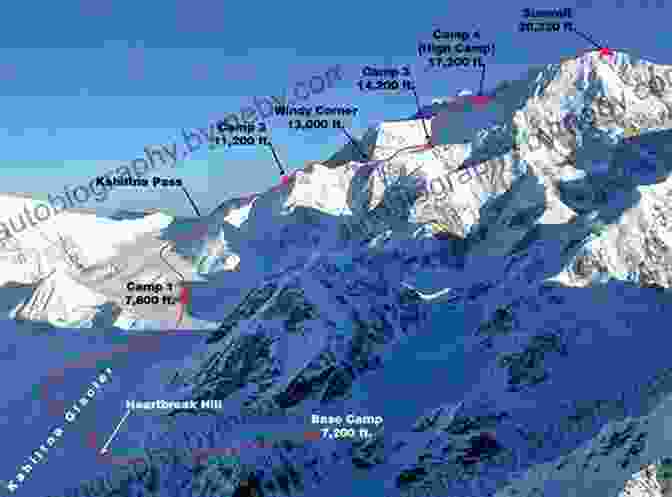The Deadliest Climbing Disaster On America's Wildest Peak

On October 6, 1996, a group of six climbers set out to summit Mount Everest. They were led by Scott Fischer, a world-renowned mountaineer. The team reached the summit on October 7, but the weather turned bad on the descent. The climbers were caught in a blizzard and died.
4.5 out of 5
| Language | : | English |
| File size | : | 12305 KB |
| Text-to-Speech | : | Enabled |
| Screen Reader | : | Supported |
| Enhanced typesetting | : | Enabled |
| X-Ray | : | Enabled |
| Word Wise | : | Enabled |
| Print length | : | 273 pages |
The disaster was the deadliest climbing disaster on Mount Everest in history. It claimed the lives of six climbers, including Fischer. The climbers were from the United States, Britain, New Zealand, and Japan.
The disaster was caused by a combination of factors, including bad weather, altitude sickness, and human error. The climbers were caught in a blizzard on the descent from the summit. The wind and snow made it difficult to see and breathe. The climbers also suffered from altitude sickness, which can cause confusion and disorientation.
The disaster has been the subject of several books and documentaries. The most famous book about the disaster is Jon Krakauer's "Into Thin Air." Krakauer was a member of the expedition and his book provides a gripping account of the disaster.
The Climbers
The six climbers who died in the disaster were:
- Scott Fischer, the expedition leader
- Rob Hall, a New Zealand mountaineer
- Doug Hansen, an American climber
- Yasuko Namba, a Japanese climber
- Tsewang Paljor, a Nepalese climber
- Andrew Harris, a British climber
The climbers were all experienced mountaineers. Fischer had summited Everest eight times, and Hall had summited Everest five times. The climbers were well-equipped and prepared for the expedition.
The Disaster
The climbers set out from Base Camp on October 6, 1996. They reached the summit on October 7. The weather was good on the summit, but it turned bad on the descent. The climbers were caught in a blizzard and died.
The climbers died from a combination of factors, including hypothermia, altitude sickness, and exhaustion. The blizzard made it difficult for the climbers to see and breathe. The climbers also suffered from altitude sickness, which can cause confusion and disorientation.
The climbers' bodies were found on the mountainside in the days following the disaster. The bodies were flown down to Base Camp and then transported to their home countries.
The Aftermath
The disaster was a tragedy for the families of the victims and for the mountaineering community. The disaster led to a number of changes in the way that Everest expeditions are conducted.
One of the most significant changes was the requirement for climbers to use supplemental oxygen on the summit. Supplemental oxygen can help to prevent altitude sickness and hypothermia.
The disaster also led to a number of changes in the way that climbers are trained. Climbers are now required to undergo more rigorous training before they are allowed to attempt Everest.
The disaster has had a lasting impact on the mountaineering community. The disaster has made climbers more aware of the dangers of Everest and has led to a number of changes in the way that Everest expeditions are conducted.
The disaster on Mount Everest in 1996 was a tragedy. The disaster claimed the lives of six climbers, including Scott Fischer. The disaster was caused by a combination of factors, including bad weather, altitude sickness, and human error. The disaster has had a lasting impact on the mountaineering community. The disaster has made climbers more aware of the dangers of Everest and has led to a number of changes in the way that Everest expeditions are conducted.
Images



4.5 out of 5
| Language | : | English |
| File size | : | 12305 KB |
| Text-to-Speech | : | Enabled |
| Screen Reader | : | Supported |
| Enhanced typesetting | : | Enabled |
| X-Ray | : | Enabled |
| Word Wise | : | Enabled |
| Print length | : | 273 pages |
Do you want to contribute by writing guest posts on this blog?
Please contact us and send us a resume of previous articles that you have written.
 Book
Book Novel
Novel Page
Page Chapter
Chapter Text
Text Story
Story Genre
Genre Reader
Reader Library
Library Paperback
Paperback E-book
E-book Magazine
Magazine Newspaper
Newspaper Paragraph
Paragraph Sentence
Sentence Bookmark
Bookmark Shelf
Shelf Glossary
Glossary Bibliography
Bibliography Foreword
Foreword Preface
Preface Synopsis
Synopsis Annotation
Annotation Footnote
Footnote Manuscript
Manuscript Scroll
Scroll Codex
Codex Tome
Tome Bestseller
Bestseller Classics
Classics Library card
Library card Narrative
Narrative Biography
Biography Autobiography
Autobiography Memoir
Memoir Reference
Reference Encyclopedia
Encyclopedia Stephen Wangh
Stephen Wangh Brandon Sanderson
Brandon Sanderson Andrew Clements
Andrew Clements Andrew Kirtzman
Andrew Kirtzman John Grier Varner
John Grier Varner Paul H Wender
Paul H Wender Andrew Carroll
Andrew Carroll Andrew M Greeley
Andrew M Greeley Andrea Moriarty
Andrea Moriarty Andrei Martyanov
Andrei Martyanov Craig S Brantley
Craig S Brantley Angela Diterlizzi
Angela Diterlizzi Heather Cullen
Heather Cullen Amy Cook
Amy Cook Jonathan Alpeyrie
Jonathan Alpeyrie Patricia A Banks
Patricia A Banks Lucia Ashta
Lucia Ashta Anne Laure Jackson
Anne Laure Jackson Traci Foust
Traci Foust Andrew Maraniss
Andrew Maraniss
Light bulbAdvertise smarter! Our strategic ad space ensures maximum exposure. Reserve your spot today!

 William ShakespeareDiscover the Enigmatic World of Turtles with "National Geographic Readers:...
William ShakespeareDiscover the Enigmatic World of Turtles with "National Geographic Readers:... Eliot FosterFollow ·6.4k
Eliot FosterFollow ·6.4k Mark TwainFollow ·6.4k
Mark TwainFollow ·6.4k Roberto BolañoFollow ·7.5k
Roberto BolañoFollow ·7.5k Herb SimmonsFollow ·14.6k
Herb SimmonsFollow ·14.6k Walt WhitmanFollow ·13.5k
Walt WhitmanFollow ·13.5k Jim CoxFollow ·19.8k
Jim CoxFollow ·19.8k Edwin CoxFollow ·18.2k
Edwin CoxFollow ·18.2k Caleb CarterFollow ·15.7k
Caleb CarterFollow ·15.7k

 Bryce Foster
Bryce FosterCelebrate the Luck of the Irish: Unveiling Saint...
As the verdant hues of spring brush...

 Chase Simmons
Chase SimmonsCody Rodeo: A Photographic Journey into the Heart of the...
Step into the arena of the...

 David Mitchell
David MitchellUnveiling the Enchanting World of Door County Quilts: A...
Step into the Heart of Amish Country in...

 Floyd Powell
Floyd PowellCowboy Chatter: Unraveling the Enigmatic Tales of the Old...
Step into the...

 Ismael Hayes
Ismael HayesUnlock Content Marketing Mastery: How to Create...
In today's digital landscape, content is...

 Boris Pasternak
Boris PasternakMore Than 200 Hardball Questions For The Thinking Fan
The Ultimate Baseball Trivia Challenge Are...
4.5 out of 5
| Language | : | English |
| File size | : | 12305 KB |
| Text-to-Speech | : | Enabled |
| Screen Reader | : | Supported |
| Enhanced typesetting | : | Enabled |
| X-Ray | : | Enabled |
| Word Wise | : | Enabled |
| Print length | : | 273 pages |










